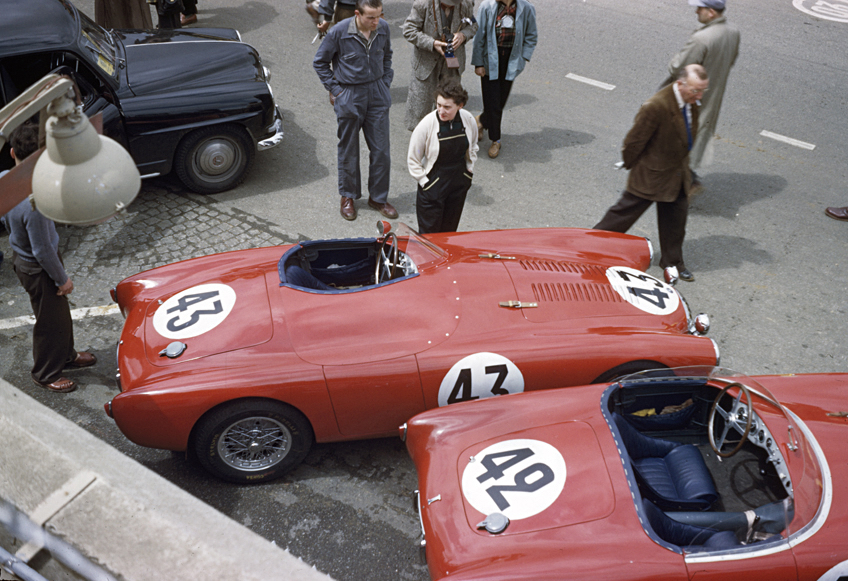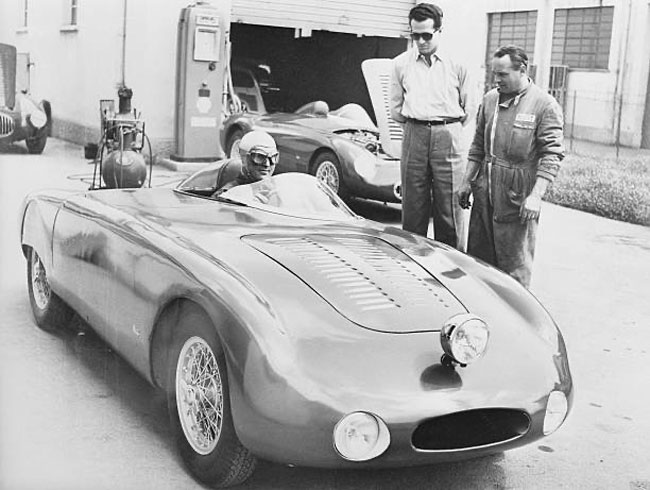COMPETITION HISTORY
For Bindo, Ettore and Ernesto, the three remaining Maserati brothers, motorsport competition was the true raison d'etre. Whether overseeing their original namesake company, Maserati S.p.A. or founding and running OSCA – Fratelli Maserati, the ambition to compete and win at the uppermost echelons of motorsports was the clear motivator.
At OSCA, the brother’s philosophy did not differ much from their pre-war days at Maserati S.p.A. They continued to focus on Italian and international sports car and single seater racing, offering very competitive machines, hand-fabricated specially for the specific purpose of the underlying course or type of competition. Alternating with highly skilled professional drivers and a multitude of amateur “gentleman drivers”, the brothers were able to attract the cream of the motorsport elite by offering them a very competitive mount. To guarantee competitiveness, the racing machines underwent constant and rapid technical evolution, thus ensuring that OSCA race cars became sure victors in the hands of the right drivers everywhere they set foot. By the early 1950’s the OSCA Mt4 became the car to beat in under 1500cc Sports cars racing, dominating its class and -remarkably- often vying for first overall.

OSCA – Fratelli Maserati business model focused on producing fantastically competitive cars, manufactured in small batches. While this romantic approach to race car manufacture allowed the Maserati brothers to solely attend to their passion, it had its clear limitations. The brother’s persistent resistance to selling road versions of their cars meant that OSCA was perennially financially constrained. Astonishingly, all design, engineering and development work was done in house and singlehandedly by Ernesto Maserati. The company not employing any additional design or test engineers in its close to two decades of operations! As the 1950’s wore on, the advent of large factory teams -from mainly Porsche, Maserati and Ferrari- meant that the brothers started to find it increasingly difficult to stay competitive. By the time the 1960’s came around, the three ageing Maserati siblings were struggling to find the resources for further race car development.
OSCA’s competitive chronology can be dissected into three main periods of activity, each characterized by a different competitive landscape, product offering and focus.
Racing debut took place on August 16th 1948 in Pescara Italy, with the first OSCA produced, Mt4 Chassis #1101. The Siluro (torpedo) shaped car equipped with a 1100cc single cam, inside plug head engine, was placed in the hands of Franco Cornacchia for the race. The fresh car showed promise in its first outing but failed to finish. Within a month Luigi “Gigi” Villoresi would pilot the same car to an overall victory at the 1948 GP of Napoli (for sports cars), handily beating the latest offering from Ferrari, Maserati, Cisitalia and others – OSCA’s first victory!
For the rest of 1948 and the entire season of 1949, race entries consisted of a combination of official factory entries and accomplished “gentleman driver”. The factory focused on contending for the 1949 1100cc Italian championship, which it handily won. By mid-1949, the single cam, inside plug head was replaced by a state-of-the-art twin-cam head on all OSCA engines, with a larger 1350cc engine option also becoming available.
By 1950, the Mt4 was considered the car to beat in the Italian 1100cc sports car racing class, at that time a highly popular and competitive field. 12 Mt4 race cars were competing all over Italy in the hands of select amateurs and professional drivers, yielding dominating results. However, factory support was sporadic - the further the event was from Bologna, the less likely a factory support crew. The body style took on a more aerodynamic enveloped shape, however the same basic mechanical principles continued to be applied to all OSCA racing machines – light, robust, neutral handling, with a powerful but efficient engine. In May, Fagioli, won his class at the 1950 Mille Miglia, in September Felice Bonetto won the Monza Gran criterium driving an Mt4. Earlier in the year, a young unassuming amateur from Verona named Giulio Cabianca, started to make a name for himself racing OSCA machines all over Italy. In the years to come he will become the pre-eminent driver for OSCA - Fratelli Maserati. At the conclusion of the season, OSCA won the 1950 Italian 1100cc championship for the second consecutive year. Fagioli wins the 1100cc class at the 1950 Mille Miglia
Fagioli wins the 1100cc class at the 1950 Mille Miglia
1951 saw rapid expansion, with the Maserati brothers boldly accepting the challenge of building a 4.5 liter V12 GP engine financed with the help of the French Amadeo Gordini, as well as designing a complete GP car. Although from the outset the engine’s potential was clear, rule changes at the end of 1951, would make the GP machine (code named Tipo G) obsolete, even before full development. Away from the Tipo G project, OSCA sports racing success continued highlighted by a class dominating 1-2-3 in April’s Mille Miglia and a 1-2-3 overall achievement Monza GP Voiturette held in September. OSCA’s geographical reach was still largely limited to Italy, but the dominance and consistency of the Mt4’s racing results meant that overseas export markets were starting to take notice.
Such was the abrupt change of F1 GP rules at the end of 1951, that 1952 was labeled a transition year, and the FIA had F2-spec cars running as the uppermost echelon of the sport. OSCA responded with its own 2 Liter, 6-cylinder F2 machine. By now it was clearly evident that motorsports away from the amateur weekend worrier, were serious business and required a consistent factory effort along with the corresponding financial resources. For the Maserati brothers, still keen to maintain an organic gentleman-driver atmosphere, results proved elusive as the 1952 F2 season wore on.
More satisfying were the results for the core sports racer category utilizing the ever evolving Tipo Mt4 . A MIlle Miglia class dominances became a usual feature (another 1-2-3 in 1952). All over Italy class wins were de-reguer, often along with a high placing in overall ranking, beating much larger-capacity machines. The Mt4 was proving ever effective, so much so that 1952 saw the first appearance of an OSCA at the 24 hours of Le Mans (#1120 – DNF). More importantly by May the first OSCA racecar (#1112) reached USA shores, winning in its first race appearance. In the following years the USA would become OSCA’s biggest and most important export market.
Italy focused
Gentleman driver
Some efforts away from amateur racing
Key models: Mt4, 4500G, F2
Key drivers: Velloresi, Fagioli, Bonetto, Chiron, Cabianca, Serafini, Bayol, Rol




